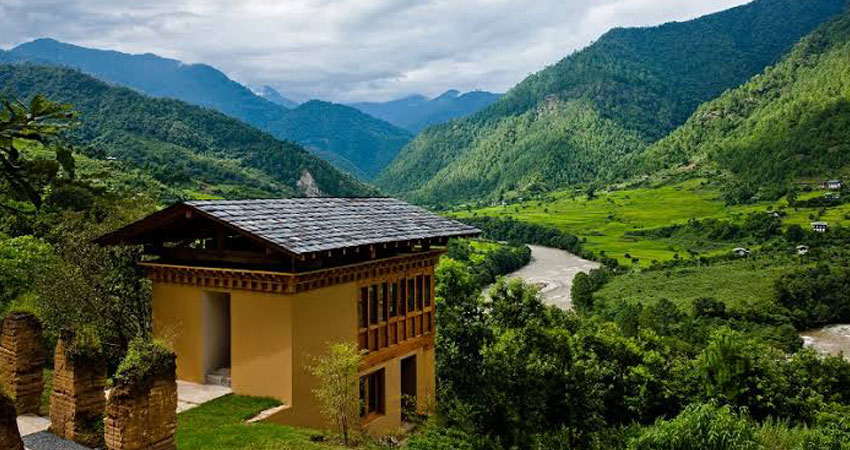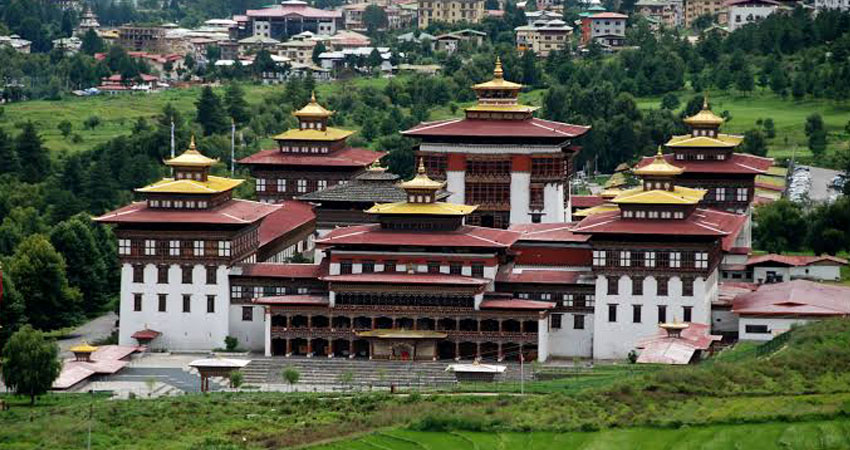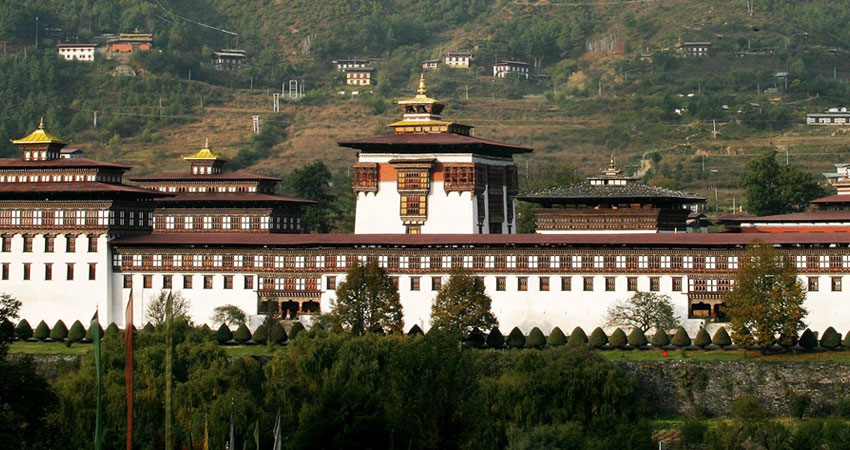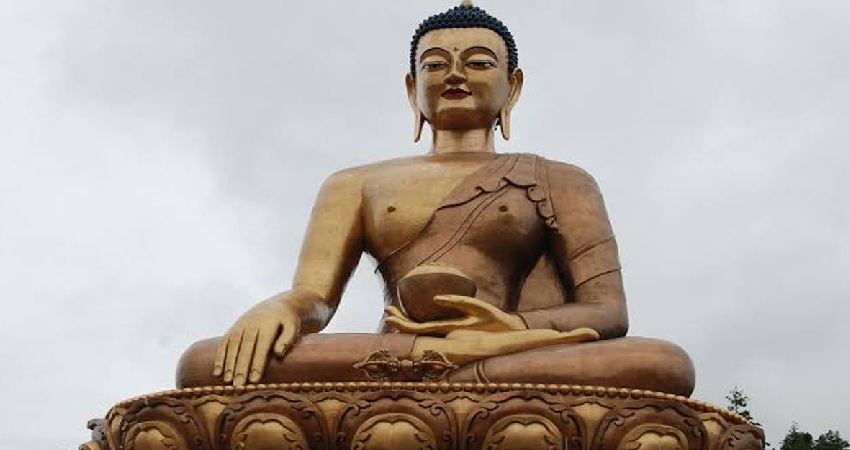









Apart from what you experience in Bhutan, its natural beauty, forest conservation, gross national happiness, great culture & heritage in the most ideally located destinations of Paro, Thimpu and Punakha, you will also explore some offbeat destination like Gangtey and Haa valley. You will get the opportunity to visit Talo village, which is scattered along the hill slopes and known for its cleanliness and hygiene. You will get the taste of Bhutanese Rural life and chance to interact with the local families during visit of Farm houses. On the way to Haa valley, you will cross one of the highest motorable Chelela passes in Bhutan. From the pass you will get the stunning view of the sacred mountain Jomolhari and Jichu Drake. You will also visit the western most edge of the country, the Haa valley, which is also known as the “Hidden-Land Rice Valley”. The valleys support the raising of yak, cattle, chicken, pigs and horses.
The flight to Paro is one of the most spectacular in entire Himalayas. Journey offers magnificent views and an exciting descent into the Kingdom. Bhutan’s first gift, one disembarks from the aircraft is the cool, clean, and rejuvenating mountain air. After immigration formalities and baggage collection, warmly received by our representative, and embark on a picturesque drive to Thimphu, the capital town of Bhutan. The road leads through the Paro valley to the confluence of Paro and Thimphu rivers at Chuzom (confluence).
Shortly before reaching Chuzom, you will see on your left Tamchog Lhakhang, the temple built by Thangtong Gyalpo, a pioneering engineer who introduced the construction of suspension bridges into Bhutan and Tibet (several of which are still in use today). Crossing this iron bridge is a wonderful experience.
On arrival, in Thimphu check into the hotel. The capital town of Bhutan and the centre of government, religion, and commerce, Thimphu is a unique city with unusual mixture of modern development alongside ancient traditions. With the population of about 1,00,000 it is perhaps still the world’s only capital city without a traffic light.
Later in afternoon walk around National Memorial Chorten, a large white structure crowned with a golden spire. It is located close to the center of Thimphu city and is one of its most iconic monuments. This is the most ideal spot to interact with locals who throng in large numbers to circumambulate the chorten, whirl the large red prayer wheels and pray at a small shrine inside the gate. The paintings and statues inside the monument provide a deep insight into Buddhist philosophy.
Afterwards take a stroll around Thimphu main street and market area.
Dinner and overnight at hotel.
Breakfast at hotel.
Drive to see the iconic gigantic Buddha Dordenma (Vajra seated), the world’s largest sitting bronze statue. Majestically situated at Kuenselphodrang, it is an object of great veneration to all sentient beings. The land at Kuenselphodrang measuring 145 acres was gifted to Monks Body by His Majesty the Fourth King of Bhutan. Dedicating it to the 60th birth anniversary celebration of His Majesty the Fourth Druk Gyalpo, His Holiness the Je Khenpo consecrated the 201 feet tall Buddha Dordenma statue at the Kuenselphodrang on 24th September 2015.
After this insightful visit drive to Textile Museum, established in 2001 under the royal patronage of Her Majesty Gyalyum Sangay Choden Wangchuck. The museum is managed by the Department of Culture, Ministry of Home & Cultural Affairs, Royal Government of Bhutan.
Institute for ZorigChusum, commonly known as Arts & Crafts School or Painting School is an important learning center that offers a six-year course on the 13 traditional arts and crafts of Bhutan. On a visit, one can see students learning the various skills taught at the school.
Located below the main town, Centenary Farmers Market popularly known as Weekend market is a pleasant, colourful & delightful place to mingle with locals. Farmers come from all over the country to sell their farm products in this market.
Then visit Changangkha Lhakhang, one of the ancient temples in Thimphu established on a site chosen by Phajo Drukgom Shigpo, the founder of Drukpa lineage in Bhutan. From temple courtyard, there is fascinating view of Thimphu valley.
Visit of Trashichhoedzong, that has been the seat of the government since 1952 and presently houses the throne room and offices of His Majesty the King, the Secretariat and the Ministries of Home Affairs and Finance. It is an impressively large structure, surrounded by well-kept lawns and beautiful gardens.
Evening free to explore the government-run Handicrafts Emporium and local crafts Bazaar.
Meals and overnight at hotel.
Breakfast at hotel.
Drive up to Dochu-la pass (3,088m/ 10,130 ft) stopping briefly here to take in the view and admire the chorten, mani wall, and prayer flags which decorate the highest point on the road. If skies are clear, the following peaks can be seen from this pass (left to right): Masagang (7,158m), Tsendagang (6,960m), Terigang (7,060m), Jejegangphugang (7,158 m ), Kangphugang (7,170 m ), Zongphugang (7, 060 m ) and finally Gangkarpuensum, the highest peak in Bhutan at 7,570m.
At Dochula Pass, 108 chortens or stupas known as Druk Wangyal Chortens have been built by Ashi Dorji Wangmo Wangchuk, the eldest Queen Mother.
Then explore some part of Royal Botanical Park: It is the first botanical park in Bhutan and forms the backdrop of the Dochula Pass. Afterwards drive onto Wangdue, taking a short lunch stop in this town.
Then drive onto Gangtey, passing through dense forests of oak and rhododendron tress. Lunch at a hotel / Restaurant.
The valley of Gangtey is one of the most beautiful and unspoiled places in Bhutan. The surprise of finding such a wide, flat valley without any trees after the hard climb through dense forests. A few kilometers beyond the Gangtey Monastery, on the valley floor lies the village of Phobjikha.
On arrival, check into the hotel.
Evening take a stroll in fascinating Phobjikha valley.
Dinner and overnight at hotel.
Early morning visit Monastic School to witness prayer ceremony.
Later breakfast at hotel & visit Gangtey Goempa (monastery), perched on a ridge overlooking the valley. It is directed by Gangtey Tulku, the ninth reincarnation (a “Tulku” is a reincarnate) of Pema Lingpa—a famous Buddhist saint and teacher.
Then a walking excursion to Gangtey Nature Trail. This pleasurable walk will give you a nice feel of Phobjikha valley. From the small hilltop overlooking Gangtey Goemba, you head downhill through flower meadows to Semchubara village and from here through beautiful forests and into the open valley. This is two hours walk.
Lunch at a local restaurant/hotel.
Post lunch explore fascinating Phobjikha valley. This place is the winter home of black necked cranes that migrate from the arid plains in the north to pass winter in milder and lower climate. The valley boasts two beautiful meandering rivers, Nakay Chhu (ChhuNaap-black water) and Gay Chhu (Chhu Karp-white water).
Also, visit Black Neck Crane Information Centre. Situated on the edge of the forest and wetland along the main road of Phobjikha valley, the black-necked crane information Centre has an observation room equipped with high power telescope and spotting scopes for catching the best view of the cranes. There is a small gift shop, which sells handicrafts produced by the local people.
Dinner and overnight at hotel.
Breakfast at hotel.
Punakha at an altitude of 1300m/4265ft, is blessed with a temperate climate, and owing to its natural drainage from Pho Chhu (male) and Mo Chhu (female) rivers, the Punakha valley produces abundant crops and fruits.
On arrival in Punakha, check into the hotel. Lunch at hotel.
Later in the day, proceed to visit Punakha Dzong, a massive structure built at the junction of two rivers. Built in the 17th century by Zhabdrung Ngawang Namgyal (who founded the Kingdom of Bhutan), the fortress once housed the country’s government. It is now the winter home of Je Khenpo, the head abbot of Bhutan, along with a retinue of 1,000 monks.
Afterwards a short walk across farmhouses and rice paddies takes you to ChimiLhakhang, a 15th-century fertility temple dedicated to Drukpa Kuenley, a Tibetan Buddhist saint, popularly better known as the ‘Divine Madman’. This site has long been a pilgrimage for couples hoping to start a family.
Dinner and overnight at hotel.
Breakfast at hotel.
Visit Sangchhen Dorji Lhuendrup Lhakhang Nunnery. Perched on a ridge amid pine trees and overlooking valleys of Punakha and Wangdue gleams Sangchhen Dorji Lhuendrup temple. It houses a 14-foot main bronze statue of Avalokiteshvara and of Guru Padsambhava. The temple complex also houses a permanent higher learning and meditation centre for nuns where, apart from religious training, it provides life skill training such as tailoring, embroidery, statue making and thangkha painting.
Thereafter, a beautiful hike takes one to the regal Khamsum Yuelley Namgel Chorten, which was built to remove negative forces and promote peace, stability and harmony in the changing world. Lunch at a hotel/restaurant.
Post lunch, excursion to Talo village, which is scattered along the hill slopes and known for its cleanliness and hygiene among Punakha villages. Talo is the seat of the mind incarnations of the Zhabdrung. Talo Sangnacholing Dzong is built on a plateau and has majestic view of surrounding villages. Spend time at Nobgang and Talo villages visiting farmhouses and meeting families, experiencing Bhutanese rural life.
Also visit Nalanda Buddhist Institute. Locals call this place ‘Dalayna’ and the monks call it Nalanda Buddhist College. Here you’ve opportunity to interact with monks, for knowledge on Buddhism, process of meditation.
Dinner and overnight at hotel.
Breakfast at hotel.
Depart to Paro, the road climbs steeply through a forest of pine and cedar.
After a short stop at Dochula, drive further en route visiting Simtokha Dzong, the place of profound tantric teaching, this dzong now houses a school for the study of the Dzongkha language.
Driving further to Chuzom where you can glimpse the three nearby shrines, built to ward off evil spirits – each with a different style of architecture: Nepalese, Tibetan, and Bhutanese.
On arrival check into hotel & Lunch.
Later in the day set out on an exploratory excursion in around Paro valley.
The beautiful valley of Paro encapsulates within itself a rich culture, scenic beauty, and hundreds of myths and legends. It is home to many of Bhutan's oldest temples and monasteries, National Museum and the country's only airport. Paro is also one of the most fertile valleys in the Kingdom producing a bulk of the locally famous red rice from its terraced fields.
Visit Ta Dzong, the National Museum, holding fascinating collection of art, relics, religious thangkha paintings, handicrafts, masks, costumes, armour and Bhutan’s exquisite postage stamps. The visit will provide an insight into the rich and unique cultural heritage and tradition of Bhutan.
Then walk down the trail to visit Rinpung Dzong, meaning (“fortress of the heap of jewels”), which has a long and fascinating history. Along the wooden galleries lining the inner courtyard are fine wall paintings illustrating Buddhist lore. Part of Bernardo Bertolucci's movie, ‘Little Buddha,’ was filmed inside this dzong.
Dinner and overnight at hotel.
Breakfast at hotel.
Embark on a walking excursion to Taktshang Monastery (approx. 5 hours, round trip walk): It is one of the most famous of Bhutan’s monasteries, perched on the side of a cliff 900m above the Paro valley floor. It is said that Guru Rinpoche arrived here on the back of a tigress and meditated at this monastery and hence it is also called ‘Tiger’s Nest’. This site has been recognized as a most sacred place and now visited by all Bhutanese at least once in their lifetime.
Late afternoon, drive to the base of Drukgyel Dzong, which is currently under restoration. On a clear day, there is fascinating view of Mount. Chomolhari (7314m) from the village below this ruined fortress. Here we will also see the beautiful typical farmhouse. Bhutanese farmhouses are very colorful, decorative and traditionally built without the use of single nail. The majority of the population of Bhutan continues to live as it has for centuries.
Drive to the base of Drukgyel Dzong, which is currently under restoration. On a clear day, there is fascinating view of Mount. Chomolhari (7314m) from the village below this ruined fortress.
While driving to Paro town, stop en route at the 7th century Kyichu Lhakhang, one of the 108 temples built in the Himalayas by Tibetan King, Songtsen Gampo. The building of this temple marks the introduction of Buddhism in Bhutan.
Evening an exploratory walk around main street and market area.
Meals and overnight stay at hotel.
Breakfast at hotel.
Drive to Haa valley, en route taking a short stop at Chelela pass. Located at an elevation of 3,988 meters, Chelela is considered to be one of the highest motorable passes in Bhutan. This Pass is a botanical paradise, providing stunning views of the sacred mountain Jomolhari and Jichu Drake.
The Haa valley was opened for the first time to foreign tourists in 2002. Also known as the “Hidden-Land Rice Valley”, Haa is culturally rich valley and some of famous sites in this region are: 7th century Lhakhang Karpo (White temple) and Lhakhang Nagpo (Black temple) at the foothills of a venerated three brotherly mountains known as Meri Puensum. The Valley of Haa lies on the western most edge of Bhutan, its northern boundaries with the Chumbi Valley of Tibet, dividing it from the Indian province of Sikkim. Haa is one of the 20 districts or dzongkhags of Bhutan and one of the least populated. Meadows support the raising of yak, cattle, chicken, pigs and horses.
Visit Lhakhang Karpo (White temple), established in the 7th century by Tibetan King Songtsen Gempo. It is situated at the foothills of the three towering mountains worshipped as ‘Rigsumgonpo’. Then visit, Lhakhang Nagpo (Black temple), built in 7th century by Tibetan King Songtsen Gempo and situated towards the north of Lhakhang Karpo. Lhakhang Nagpo serves as the seat for the guardian deity ‘Da Do Chen’. Both these temples stand as the guardian sentinels keeping watch at the south entrance of Haa valley.
Then take a walk around charming, little villages and explore the exotic town.
Lunch at a local restaurant / hotel.
Late afternoon return to Paro.
Evening at leisure in Paro city centre, followed by dinner.
Dinner and overnight at hotel.
Breakfast at hotel.
Drive to the airport for the flight to your onward destination.